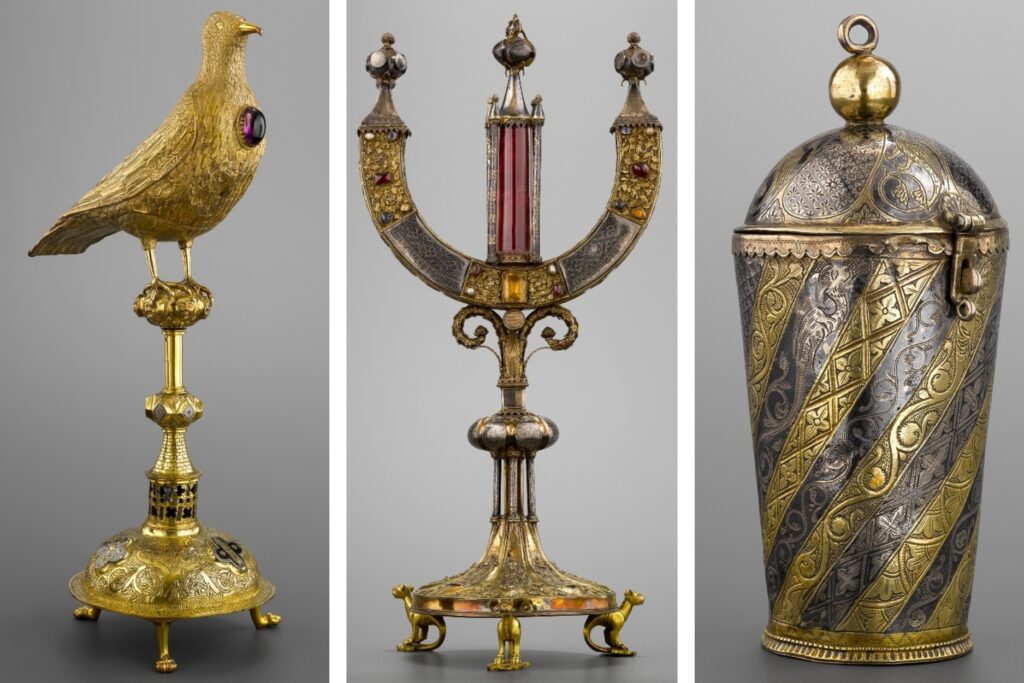The 'Merveilleux Trésor d'Oignies: éclats du XIIIe siècle' exhibition ('The Wonderful Treasure of Oignies: Glimpses into the 13th century'), a rare collection of over 30 pieces of Belgian gold and silverware, opened at the Musée National du Moyen Âge de Cluny in Paris on Tuesday 19 March.
The exhibition is a joint initiative by the Paris museum and the Musée des Arts Anciens du Namurois (TreM.a), with support of the King Baudouin Foundation (KBF), the owner of the collection. It will run until 20 October 2024.
This is the first time most of the treasure trove has ventured outside Belgium: the last time was at the Musée du Louvre in 1924, when three pieces were exhibited.
The Brussels Times attended the exhibition on Thursday alongside Julien De Vos, General Curator and Director of the Cultural Heritage Department in Namur, and Christine Descatoire, General Curator at the Musée de Cluny responsible for the gold and silver collections, to find out why the collection is so unique.

The Musée de Cluny, Paris. Credit: Musée de Cluny / Facebook
The Treasure of Oignies dates back to the 13th century, but its eight-century-long story has been well-recorded. "Most of the pieces were crafted between 1226 and 1240, and all have remained intact," De Vos told The Brussels Times. The works are mainly religious reliquaries, including chalices, cross-reliquaries and phylacteries, as well as a selection of textiles.
As a result, the collection deservedly earned the title as one of the 'Seven Wonders of Belgium', an initiative established by Arthur Haulot, the former General Commissioner for Tourism, in 1978 to promote tourism in Belgium.
The list of wonders includes works chosen from seven Belgian cities: three in Flanders, three in Wallonia and one in the Brussels-Capital Region. Among them are the Ghent Altarpiece, Landscape with the Fall of Icarus in Brussels, and the Baptismal Font in Liège. All are significant works of medieval or Flemish Renaissance art.
'Make this treasure accessible to everyone'
The new exhibition in Paris is a "conjunction of circumstances," according to Jean-Marc Van Espen, Deputy President of the College in Namur. The works had to be given a home because of major renovation works at the TreM.a. Since the treasure was transferred to the KBF in 2010, the foundation has reiterated its desire to "make this treasure accessible to everyone." The close links between the two museums in Namur and Paris made this partnership possible.
However, the Paris exhibition wants to bring something new to the table: the curators have decided to change the setting and arrangement of the medieval pieces, and retell the history of the priory of Saint-Nicolas d'Oignies. Without the priory's three key figures, Hugo de Walcourt, Marie d'Oignies and Jacques de Vitry, the treasure would never have seen the light of day, as explained in the exhibition.
Central to the treasure's creation was the goldsmith Hugo de Walcourt, known as 'Hugo d'Oignies'. He was the youngest of four brothers. His three elder brothers were priests and founded the priory. Hugo's works are characterised by their "mastery of mixing and combining techniques," stated the two curators.
The goldsmith was very religious, and represented himself in his pieces as "a way of singing and praying to Christ," explained Descatoire. This can be seen in the bottom left corner of Christ in Majesty on the Evangeliary.

Binding covers for the Evangeliary. Credit: King Baudouin Foundation
Marie d'Oignies enjoyed a substantial reputation and made the priory famous. During her lifetime, sick children and people in spiritual distress were brought to Marie. As a profoundly religious woman, she wanted to "become one spirit with the Lord." She often mortified herself to imitate the Passion of Christ.
Marie played an indirect role in the creation of this treasure. Indeed, it was her reputation that brought French historian and bishop Jacques de Vitry to Oignies in 1208 to retrace her life. It was only in 1220 – 12 years after Marie's death – that Hugo started his first works. To make this possible, de Vitry became the goldsmith's principal patron, providing objects, relics, and precious stones from his travels during the Crusades.
Descatoire noted that the conservation of its reliquaries is undoubtedly one of the facts that makes it all the more extraordinary. Indeed, the treasure was hidden away before the priory was destroyed during the French Revolution. In 1818, the last prior entrusted it to the sisters of Notre-Dame in Namur.
Later, during the Second World War, Hermann Goering is said to "have sought to seize the treasure," said Descatoire. The nuns who held it at the time knew that it would be coveted and hid it in a farmhouse.
Since 2010, the King Baudouin Foundation has been responsible for ensuring the conservation and protection of this invaluable heritage.

